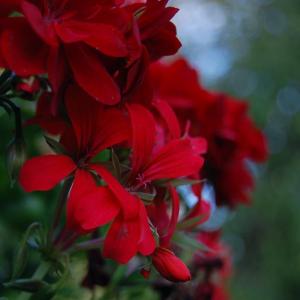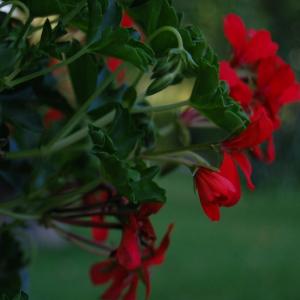
GERANIUM ESSENTIAL OIL (PELARGONIUM GRAVEOLENS) - ESSENTIAL OILS

BASE / GENERAL DATA
Information submited: April 22, 2015 Modified: March 13, 2018 By: OperaDreamhouse
Botanical Name: Pelargonium graveolens
Common Method of Extraction: Steam distillation
Part Typically Used: Flowers, leaves
Color: Ranges in Color From Clear to Amber
Consistency: Thin
Perfumery Note: Middle
Strength of Initial Aroma: Floral, fresh, sweet, with a fruity note.
Common names include Rose Geranium, Old Fashion Rose Geranium, and Rose-Scent Geranium. Pelargonium Graveolens is also known by taxonomic synonyms "Geranium Terebinthinaceum Cav."
The true Pelargonium Graveolens is an uncommon species in the Pelargonium genus, which is native to South Africa, Zimbabwe and Mozambique. Plants sometimes cultivated under this name and also as Pelargonium "Graveolens" differ from wild specimens and are of hybrid origin.
Geranium is a perennial shrub with pointy, serrated leaves and small, pink, aromatic flowers. Like Rose, there are many species and cultivars of Geranium (in a variety of colors) but Pelargonium Graveolens is generally the species used for aromatherapy purposes.
Pelargonium Graveolens cultivars have a wide variety of smells, including Rose, Citrus, Mint, Coconut and Nutmeg, as well as various fruits. However, the most commercially important varieties are those with Rose scents.
Rose Geranium has a Rose - like aroma and, as an essential oil in aromatherapy, it is often used to either adulterate rose oil or as a substitute for Rose oil. However, both plants are botanically different.
There are about 700 different varieties of the plant, yet only 10 supply essential oil in viable quantities, as the normal garden geranium produce far too little oil for extraction.
Pelargonium is a Greek word derived from Palargos meaning "Stork". The French Chemist Recluz was the first to distil the leaves of Geranium in 1819.
Pelargonium Graveolens is native to South Africa. During the 17th century, it was introduced to Europe and is now cultivated in such areas such as Spain, Italy and France due to it's fragrance which is sold commercially.
Chemical structure:
The essential oil is composed of various chemical constituentsand includes a-pinene, myrcene, limonene, menthone, linalool, geranyl acetate, citronellol, geraniol and geranyl butyrate.
A modern analysis listed the presence of over 50 organic compounds in the essential oil of Pelargonium Graveolens from an Australian source. Analyses of Indian Geranium oils indicated a similar phytochemical profile, and showed that the major constituents (in terms of % composition) were citronellol + nerol and geraniol.
Common Method of Extraction: Steam distillation
Part Typically Used: Flowers, leaves
Color: Ranges in Color From Clear to Amber
Consistency: Thin
Perfumery Note: Middle
Strength of Initial Aroma: Floral, fresh, sweet, with a fruity note.
Common names include Rose Geranium, Old Fashion Rose Geranium, and Rose-Scent Geranium. Pelargonium Graveolens is also known by taxonomic synonyms "Geranium Terebinthinaceum Cav."
The true Pelargonium Graveolens is an uncommon species in the Pelargonium genus, which is native to South Africa, Zimbabwe and Mozambique. Plants sometimes cultivated under this name and also as Pelargonium "Graveolens" differ from wild specimens and are of hybrid origin.
Geranium is a perennial shrub with pointy, serrated leaves and small, pink, aromatic flowers. Like Rose, there are many species and cultivars of Geranium (in a variety of colors) but Pelargonium Graveolens is generally the species used for aromatherapy purposes.
Pelargonium Graveolens cultivars have a wide variety of smells, including Rose, Citrus, Mint, Coconut and Nutmeg, as well as various fruits. However, the most commercially important varieties are those with Rose scents.
Rose Geranium has a Rose - like aroma and, as an essential oil in aromatherapy, it is often used to either adulterate rose oil or as a substitute for Rose oil. However, both plants are botanically different.
There are about 700 different varieties of the plant, yet only 10 supply essential oil in viable quantities, as the normal garden geranium produce far too little oil for extraction.
Pelargonium is a Greek word derived from Palargos meaning "Stork". The French Chemist Recluz was the first to distil the leaves of Geranium in 1819.
Pelargonium Graveolens is native to South Africa. During the 17th century, it was introduced to Europe and is now cultivated in such areas such as Spain, Italy and France due to it's fragrance which is sold commercially.
Chemical structure:
The essential oil is composed of various chemical constituentsand includes a-pinene, myrcene, limonene, menthone, linalool, geranyl acetate, citronellol, geraniol and geranyl butyrate.
A modern analysis listed the presence of over 50 organic compounds in the essential oil of Pelargonium Graveolens from an Australian source. Analyses of Indian Geranium oils indicated a similar phytochemical profile, and showed that the major constituents (in terms of % composition) were citronellol + nerol and geraniol.

SPIRITUAL PRACTISES DATA

MEDICINE / HEALTH DATA

BEAUTY / COSMETICS DATA

FOOD / COOKING DATA
COMMENTS
No comments.
Newest mixtures containing Geranium Essential Oil (Pelargonium Graveolens) :

Softening hand balm
August 19, 2015




